The Telecom Cloud Market is estimated to be valued at USD 36.7 billion in 2025 and is projected to reach USD 151.0 billion by 2035, registering a compound annual growth rate (CAGR) of 15.2% over the forecast period.
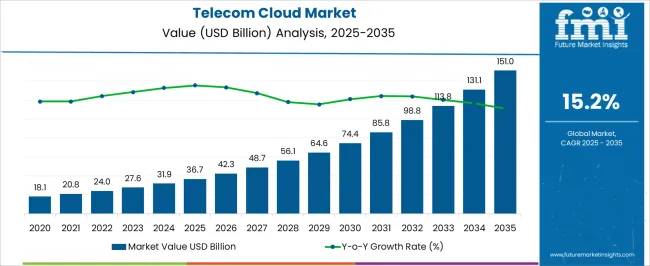
| Metric | Value |
|---|---|
| Telecom Cloud Market Estimated Value in (2025 E) | USD 36.7 billion |
| Telecom Cloud Market Forecast Value in (2035 F) | USD 151.0 billion |
| Forecast CAGR (2025 to 2035) | 15.2% |
The telecom cloud market is undergoing a major transition as telecom operators shift from legacy hardware-based systems to cloud-first network infrastructure. This transformation is being driven by the growing need for agility, scalability, and cost efficiency in delivering next-generation services such as 5G, edge computing, and network function virtualization.
Telecom service providers are increasingly partnering with hyperscalers and platform companies to modernize core and access networks using containerized architectures and open standards. Software-driven operations are enabling dynamic bandwidth provisioning, predictive network maintenance, and real-time traffic optimization.
Regulatory requirements around data sovereignty and secure cloud access are shaping regional deployments while enterprise connectivity needs are propelling demand for cloud-native telecom platforms. As operators embrace cloud operating models and integrate artificial intelligence into network orchestration, the market is expected to expand with a focus on monetizing new services and reducing operational overhead.
The market is segmented by Type, Cloud Computing Service, Application, Service, and Organization Size and region. By Type, the market is divided into Public Cloud, Private Cloud, and Hybrid Cloud. In terms of Cloud Computing Service, the market is classified into SaaS, IaaS, and PaaS. Based on Application, the market is segmented into Enterprise Application, Data Storage, Archiving, Computing, and Other Applications. By Service, the market is divided into Colocation Services, Network Services, and Management Service. By Organization Size, the market is segmented into Large Enterprise and SMEs. Regionally, the market is classified into North America, Latin America, Western Europe, Eastern Europe, Balkan & Baltic Countries, Russia & Belarus, Central Asia, East Asia, South Asia & Pacific, and the Middle East & Africa.
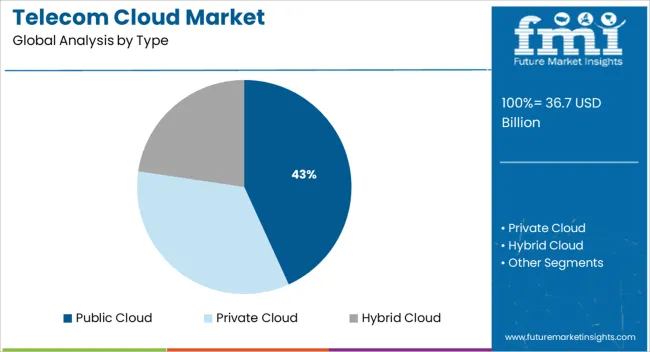
The public cloud segment is projected to account for 43.2% of the overall revenue in 2025 within the type category, marking it as the leading segment. This dominance is being driven by its ability to offer scalable infrastructure, rapid deployment, and lower capital expenditure for telecom operators.
Public cloud platforms enable seamless access to advanced tools such as AI-powered analytics, automation services, and developer-friendly environments which support rapid innovation. Operators have been leveraging public cloud environments to host virtualized network functions and deploy containerized services without maintaining physical data centers.
The growing collaboration between telecom operators and public cloud providers has also facilitated region-specific cloud zones to meet regulatory and latency requirements. As telecom operators expand their service portfolios across consumer and enterprise verticals, public cloud platforms are being preferred for their elasticity, multi-tenant architecture, and reduced infrastructure maintenance responsibilities.
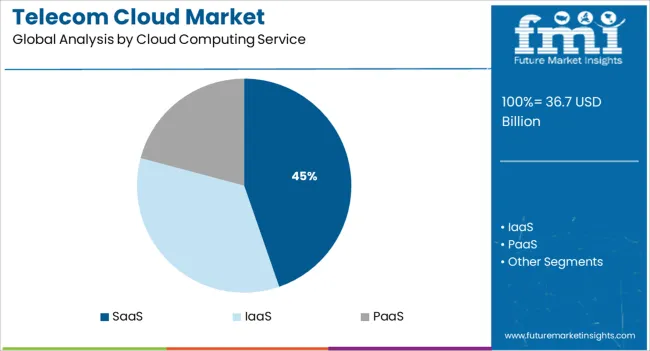
The SaaS segment is expected to hold a leading 44.7% revenue share in the overall telecom cloud market by 2025 under the cloud computing service category. This leadership is attributed to the growing adoption of cloud-based OSS BSS platforms, collaboration tools, and CRM systems by telecom operators.
SaaS models offer telecom providers a way to rapidly deploy services, reduce IT complexity, and continuously update applications without incurring major infrastructure costs. Telecom firms are utilizing SaaS-based platforms to manage customer experiences, billing operations, workforce automation, and network monitoring functions.
The predictable subscription-based pricing structure of SaaS and its compatibility with mobile-first environments have further driven its appeal. Additionally, the integration of AI and machine learning into SaaS platforms has enabled smarter decision-making and improved service personalization, reinforcing its leading position within the telecom cloud service stack.
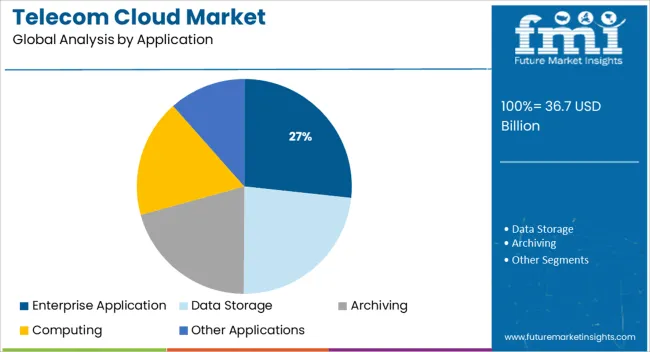
The enterprise application segment is forecast to contribute 26.7% of total telecom cloud revenue in 2025, positioning it as the top application segment. This growth has been fueled by the increasing demand from enterprises for agile, secure, and low-latency connectivity solutions to support digital transformation initiatives.
Telecom operators are deploying cloud-based enterprise applications that offer unified communications, secure remote access, and real-time collaboration for hybrid workforces. Enterprise customers have shown strong preference for scalable cloud-based networking and storage applications that align with their evolving business models.
Cloud-native enterprise applications also facilitate integration with SD-WAN, IoT platforms, and edge services, enabling seamless digital workflows across distributed environments. As more businesses rely on telecom providers for integrated connectivity and application solutions, the enterprise application segment is set to remain central to the telecom cloud monetization strategy.
As per the Telecom Cloud Market research by Future Market Insights - a market research and competitive intelligence provider, historically, from 2020 to 2024, the value of the Telecom Cloud Market increased at around 22% CAGR. With an absolute dollar opportunity of USD 151 Billion, the market is expected to reach a valuation of USD 99.4 Billion by 2035.
Rapid digitization is prompting companies to modify their operational landscapes to enhance the rate of operations and decrease their expenses. Businesses are adeptly capable of supporting their essential business operations, migrating workloads to the cloud, and preventing network latency by using cloud-based technologies and services.
Technologies such as AI and machine learning have resulted in the growth of cloud hosting by making it possible to access AI functions. In October 2024, Microsoft Corp. announced a collaboration with ZEISS Group to improve healthcare and production quality through analytics techniques.
Under this collaboration, ZEISS Group aimed to use Microsoft Azure like its cloud platform to deliver online experience to its German manufacturers, respond quickly to changing market circumstances, and boost performance and effectiveness.
Cyberattacks are projected to hit an all-time high with the advent of 5G technology. Ensured cybersecurity will be critical, necessitating the participation of enterprises and governments all around the world. To improve their products, some cloud vendors are collaborating with security suppliers.
In December 2020, Google Cloud announced partnerships with Fortinet, McAfee, and Palo Alto. Assuring excellent cloud security will aid telecom corporations in quickly shifting to the public cloud.
Owing to the growth in adoption of 5G technology, telecom businesses are considering cloud migration. As 5G becomes cloud-native from the beginning, telecom operators must migrate to the public cloud to operate and test container-based apps.
Amazon introduced its Amazon Wavelength 5G edge-computing system in December 2020, which aids in the development of apps for 5G network end-users. Verizon, Vodafone, and SK Telecom are among Amazon's market partners.
The lower operational cost structure, automated procedures, and expeditiousness of the public cloud give a critical push for telecom enterprises to shift to the service.
Organizations are inclined to focus on the protection of the information itself while any data-intensive processes are performed. Recently, several studies have revealed that around 60% of business-sensitive data on hard drives stays unsecure.
Some of the essential security services provided by vendors include encryption technology, authorization management, security systems, cloud connectivity, communication security, monitoring and auditing, and business continuity services.
Companies including Google LLP, Microsoft Corporation, and Amazon, for example, provide 99.9% uptime, relieving enterprises of the burden of supporting restoration facilities and backup infrastructure.
Telecom behemoths like AT&T and Verizon are collaborating with cloud services like Microsoft and Amazon to provide edge computing to network centers, since improvements are necessary for improved 5G deployment.
In 2024, North America led the Telecom Cloud Market with an overall revenue share of more than 40%. Companies in the United States place a high value on digitalization and are more often considered as early adopters of next-generation technology such as the Internet of Things, additive manufacturing, big data analytics, connected businesses, intelligent systems, AR, ML, and VR, as well as the most recent telecommunication technologies including 4G, 5G, and LTE.
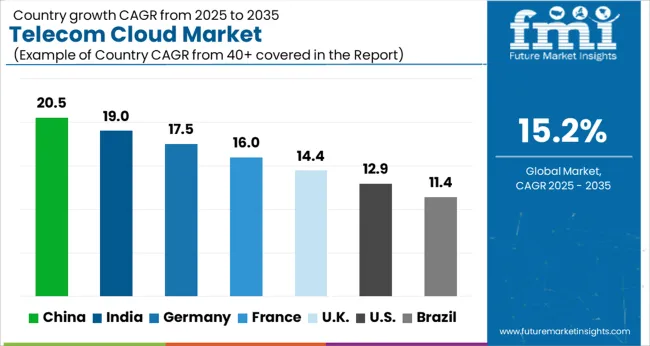
The United States is expected to account for the largest market share of USD 151 Billion by the end of 2035 with North America being the dominant player and accounting for 38% of total sales.
The Ericsson-Intel Tech Hub would identify and prioritise innovations for the Ericsson Cloud RAN, which is driven by Intel technology in order to chart a course for future business software releases.
The companies have created a technological cluster in California, US. It focuses on the benefits that Ericsson Cloud RAN with Intel technology may offer, such as greater energy efficiency and network management, shorter time to market, and monetization of new business opportunities such as corporate apps.
Public Cloud segment is forecasted to grow at the highest CAGR of over 15.2% during 2025-2035. The use of the public cloud is an evolutionary path of technological evolution, operational adjustments, and service evolution.
The public cloud's technological progress, as well as larger cloudification activities, is a significant enabler for the digital telecom sector. CSPs can drive service convergence through intelligently integrating segregated internal processes owing to the operational advances in cloud efficiency.
The investment bank's intentions are similar to those of exchanges operator Nasdaq Inc. & CME Group Inc. which have collaborated with Amazon & Alphabet Inc.'s Google to shift data and eventually, trade services to the cloud. One of the several fastest-growing areas of technology is cloud computing which allows businesses to outsource data and manage storage to large computer corporations rather than managing the systems in-house.
Saudi Telecom Company has signed a joint venture contract with eWTP Arabia Innovation and technology Limited Company, Alibaba Cloud Private Limited, Saudi Company for Artificial Intelligence, and Saudi Information Technology Company to form a limited liability company specializing in cloud computing services.
The new Company's business model coincides with STC's business expansion goal, as well as Saudi Arabia's Vision 2035 towards hyper-scale cloud technology.
The BFSI segment is forecasted to grow at the highest CAGR of over 15.1% during 2025-2035. The BFSI industry has seen an expansion of online banking business, prompting lenders to adopt digital innovation, with cloud technology playing a crucial role.
Cloud computing has assisted organizations in the BFSI industry to reduce costs, boost innovation, develop customer relationships, and increasing flexibility. The cloud services have been expanding into the financial sector, an area that has lagged behind other industries as financial institutions face regulatory constraints and security concerns that limit how much they can operate on a public cloud.
Google Cloud has entered into agreements between HSBC Holdings Plc as well as Deutsche Bank AG. Microsoft Corp. and Alibaba Group Holding Ltd.
Jefferies Financial Group Inc. has collaborated with Amazon.com Inc. to deploy its information-technology systems to the cloud. This is the latest step by a financial business that has just begun to grow into cloud-based technology and data analytics. In a four-year arrangement with Amazon Web Services enables Jefferies to migrate its key business processes, internal and customer-facing apps, IT resources, as well as data to AWS.
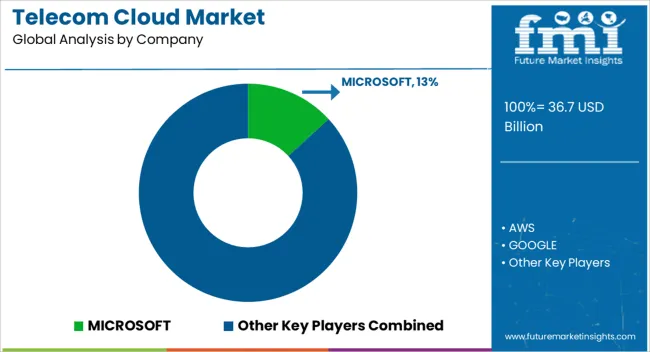
The leading players in the global Telecom Cloud market are Alibaba Group Holding Limited, Amazon.com Inc., Google LLC, IBM Corporation; Microsoft Corporation, Oracle Corporation, and Salesforce.com Inc.
Several new firms are projected to enter the market as global demand for the product grows. This is likely to boost competition on a global basis. Furthermore, partnerships among present players to increase quality during the study period are likely to drive market expansion.
Similarly, recent developments related to companies in Telecom Cloud Market have been tracked by the team at Future Market Insights, which is available in the full report.
The global telecom cloud market is estimated to be valued at USD 36.7 billion in 2025.
The market size for the telecom cloud market is projected to reach USD 151.0 billion by 2035.
The telecom cloud market is expected to grow at a 15.2% CAGR between 2025 and 2035.
The key product types in telecom cloud market are public cloud, private cloud and hybrid cloud.
In terms of cloud computing service, saas segment to command 44.7% share in the telecom cloud market in 2025.






Our Research Products

The "Full Research Suite" delivers actionable market intel, deep dives on markets or technologies, so clients act faster, cut risk, and unlock growth.

The Leaderboard benchmarks and ranks top vendors, classifying them as Established Leaders, Leading Challengers, or Disruptors & Challengers.

Locates where complements amplify value and substitutes erode it, forecasting net impact by horizon

We deliver granular, decision-grade intel: market sizing, 5-year forecasts, pricing, adoption, usage, revenue, and operational KPIs—plus competitor tracking, regulation, and value chains—across 60 countries broadly.

Spot the shifts before they hit your P&L. We track inflection points, adoption curves, pricing moves, and ecosystem plays to show where demand is heading, why it is changing, and what to do next across high-growth markets and disruptive tech

Real-time reads of user behavior. We track shifting priorities, perceptions of today’s and next-gen services, and provider experience, then pace how fast tech moves from trial to adoption, blending buyer, consumer, and channel inputs with social signals (#WhySwitch, #UX).

Partner with our analyst team to build a custom report designed around your business priorities. From analysing market trends to assessing competitors or crafting bespoke datasets, we tailor insights to your needs.
Supplier Intelligence
Discovery & Profiling
Capacity & Footprint
Performance & Risk
Compliance & Governance
Commercial Readiness
Who Supplies Whom
Scorecards & Shortlists
Playbooks & Docs
Category Intelligence
Definition & Scope
Demand & Use Cases
Cost Drivers
Market Structure
Supply Chain Map
Trade & Policy
Operating Norms
Deliverables
Buyer Intelligence
Account Basics
Spend & Scope
Procurement Model
Vendor Requirements
Terms & Policies
Entry Strategy
Pain Points & Triggers
Outputs
Pricing Analysis
Benchmarks
Trends
Should-Cost
Indexation
Landed Cost
Commercial Terms
Deliverables
Brand Analysis
Positioning & Value Prop
Share & Presence
Customer Evidence
Go-to-Market
Digital & Reputation
Compliance & Trust
KPIs & Gaps
Outputs
Full Research Suite comprises of:
Market outlook & trends analysis
Interviews & case studies
Strategic recommendations
Vendor profiles & capabilities analysis
5-year forecasts
8 regions and 60+ country-level data splits
Market segment data splits
12 months of continuous data updates
DELIVERED AS:
PDF EXCEL ONLINE
Telecom Site Management Software Market Size and Share Forecast Outlook 2025 to 2035
Telecom Tower Power System Market Size and Share Forecast Outlook 2025 to 2035
Telecom Mounting Hardware Market Size and Share Forecast Outlook 2025 to 2035
Telecom Billing And Revenue Management Market Size and Share Forecast Outlook 2025 to 2035
Telecom Testing Equipment Market Size and Share Forecast Outlook 2025 to 2035
Telecom Analytics Market Size and Share Forecast Outlook 2025 to 2035
Telecom Internet Of Things (IoT) Market Size and Share Forecast Outlook 2025 to 2035
Telecom Tower Power System Market Analysis - Size, Share, and Forecast Outlook 2025 to 2035
Telecom Network Infrastructure Market Analysis - Size, Share, and Forecast Outlook 2025 to 2035
Telecom Generator Market Size and Share Forecast Outlook 2025 to 2035
Telecom Power Rental Market Size and Share Forecast Outlook 2025 to 2035
Telecom Millimeter Wave Technology Market Size and Share Forecast Outlook 2025 to 2035
telecom-expense-management-market-market-value-analysis
Telecom Order Management Market Size and Share Forecast Outlook 2025 to 2035
Telecom Equipment Market Size and Share Forecast Outlook 2025 to 2035
Telecom Power Systems Market Size and Share Forecast Outlook 2025 to 2035
Telecom Wireless Data Market Size and Share Forecast Outlook 2025 to 2035
Telecom Managed Service Market Trends - Growth & Forecast 2025 to 2035
Telecommunications Services Market - Growth & Forecast 2025 to 2035
Telecom Enterprise Services Market Analysis - Growth & Forecast through 2034

Thank you!
You will receive an email from our Business Development Manager. Please be sure to check your SPAM/JUNK folder too.
Chat With
MaRIA